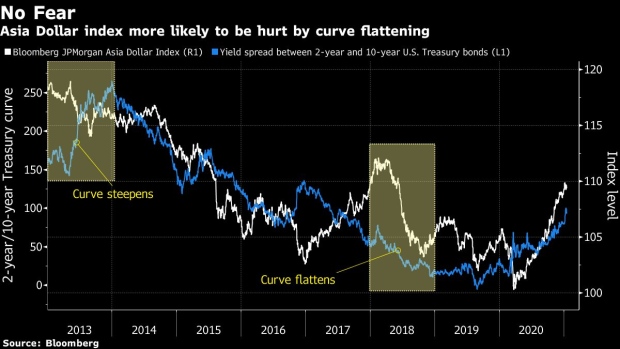Jan 18, 2021
History Shows Asian Currencies Can Weather Steeper Yield Curve
, Bloomberg News

(Bloomberg) --
Asian currencies may be able to stave off depreciation pressures from a steeper U.S. yield curve, if history is any guide.
While the advance in Treasury 10-year yields above 1% this month has raised concern that this will choke off demand for emerging-market assets, previous episodes in 2013 and 2018 show the region’s exchange rates are more vulnerable to periods of an increasing federal funds rate and a flattening curve.
The Bloomberg JPMorgan Asia Dollar Index, which tracks 10 regional currencies, fell 4.6% to a trough from a peak in 2013, as the U.S. yield curve steepened by around 100 basis points. A prolonged flattening of the curve in 2018 -- spurred by the Federal Reserve’s move to raise short-term rates above 1% -- saw the gauge drop as much as 8.1%. Coupled with stronger growth in Asia, driven by China where the economy expanded 2.3% in 2020, regional currencies look set to remain resilient, at least until the Fed starts raising rates.
“The main driver of higher yields this time is not expectations that the Fed will be hiking soon, but rather due to a bigger U.S. fiscal deficit, a strong growth rebound being priced in and higher inflation expectations,” said Khoon Goh, head of Asia research at Australia & New Zealand Banking Group Ltd. in Singapore. “A stronger economic recovery in Asia will also help to blunt the impact of higher U.S. yields on Asian currencies, as foreign investor inflows into the region will remain robust.”
Read More: Fear Not King Dollar. EM FX Can Still Rally, BNP Asset Says
Asian currencies have rallied for seven straight months against the dollar with the Bloomberg-JPMorgan index reaching the highest level since 2018 earlier in January. While gains have paused in recent days, investors and strategists at companies such as BNP Paribas Asset Management and Goldman Sachs Group Inc. still expect developing-nation exchange rates to thrive in a higher rates environment.
There’s also the dollar stance of Janet Yellen as Treasury Secretary to consider. Yellen, who’s set to testify to the Senate Finance Committee on Tuesday, will say the U.S. is committed to a market-determined value of the dollar, the Wall Street Journal reported.
“While Asia FX may face some short-term headwinds, I don’t think the higher yields driven by a dollar rebound will be sustainable, given the virus and economic backdrop in the U.S.,” said Stephen Chiu, a currency and rates strategist at Bloomberg Intelligence in Hong Kong. “The Fed may stay committed to keep rates near zero through 2023 and continuing on asset purchases, hence rendering the broad dollar weakness intact,” he said, adding that the Asian currency index may rise as much as 10% this year.
©2021 Bloomberg L.P.